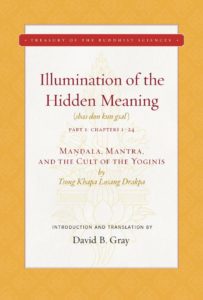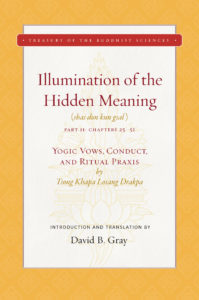
The American Institute of Buddhist Studies
Associated Literature
The Treasury of Buddhist Sciences
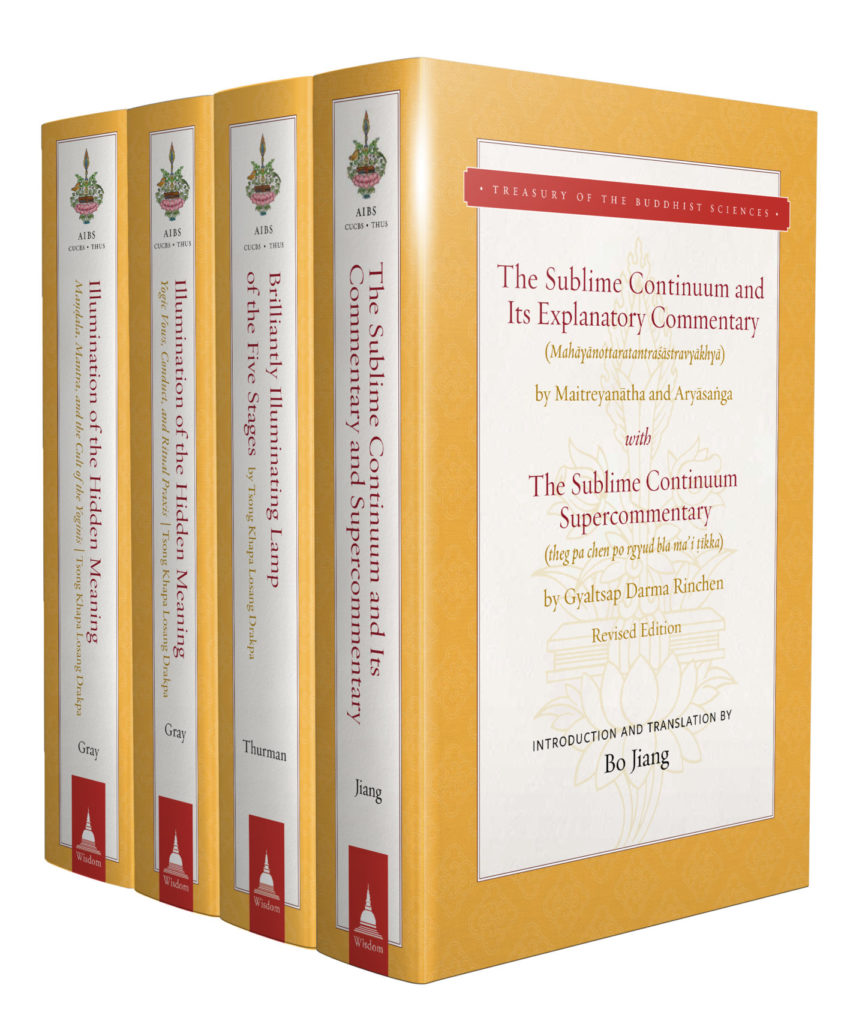 The Tibetan scholar-practitioner tradition’s literature is an immense treasury of insightful analytic and instructional works on the scriptures and scientific treatises of the Buddhist canon. This series is devoted to that literature, the basis of a still vibrant curriculum of teaching and experiential practice.
The Tibetan scholar-practitioner tradition’s literature is an immense treasury of insightful analytic and instructional works on the scriptures and scientific treatises of the Buddhist canon. This series is devoted to that literature, the basis of a still vibrant curriculum of teaching and experiential practice.
Explore the Series
LATEST RELEASE
THE SUBLIME CONTINUUM AND ITS EXPLANATORY COMMENTARY
With the Sublime Continuum Supercommentary
By Bo Jiang
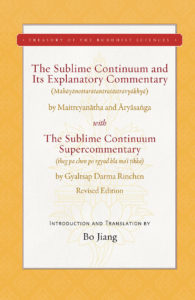 The original Sublime Continuum Explanatory Commentary was written by Noble Asanga to explain the verses received from the bodhisattva Maitreya in the late fourth century CE in northern India. Here it is introduced and presented in an original translation from Sanskrit and Tibetan, with the translation of an extensive Tibetan Supercommentary by Gyaltsap Darma Rinchen (1364–1432), whose work closely followed the view of his teacher, Tsong Khapa (1357–1419).
The original Sublime Continuum Explanatory Commentary was written by Noble Asanga to explain the verses received from the bodhisattva Maitreya in the late fourth century CE in northern India. Here it is introduced and presented in an original translation from Sanskrit and Tibetan, with the translation of an extensive Tibetan Supercommentary by Gyaltsap Darma Rinchen (1364–1432), whose work closely followed the view of his teacher, Tsong Khapa (1357–1419).
Contemporary scholars have widely misunderstood the Buddhist Centrist (Madhyamaka) teaching of emptiness, or selflessness, as either a form of nihilism or a radical skepticism. Yet Buddhist philosophers from Nagarjuna on have shown that the negation of intrinsic reality, when accurately understood, affirms the supreme value of relative realities. Gyaltsap Darma Rinchen, in his Supercommentary, elucidates a highly positive theory of buddha nature, showing how the wisdom of emptiness empowers the compassionate life of the enlightened, as it is touched by its oneness with the truth body of all buddhas. With his clear study of Gyaltsap’s insight and his original English translation, Bo Jiang completes his historic project of studying and presenting these works from Sanskrit and Tibetan in both Chinese and, now, English translations, in linked publications.
OTHER VOLUMES IN THE SERIES
BRILLIANTLY ILLUMINATING LAMP OF THE FIVE STAGES
Practical Instruction in the King of Tantras, The Glorious Esoteric Community
By Tsong Khapa Losang Drakpa
Introduced and Translation by Robert A.F. Thurman
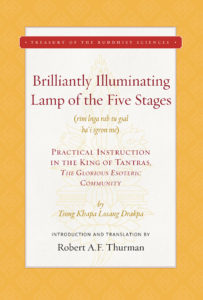 The Brilliantly Illuminating Lamp of the Five Stages (rim lnga rab tu gsal ba’i sgron me) is Tsong Khapa’s master commentary on the perfection-stage practices of the Esoteric Community (Guhyasamāja), the tantra he considered fundamental for the “father tantra” class of unexcelled yoga tantras, as the primary source for the development of the “magic body” technique for attaining buddhahood. Based on Nāgārjuna’s Five Stages (Pañcakrama) and Āryadeva’s Lamp That Integrates the Practices (Caryāmelāpakapradīpa), as well as a vast range of other works by Indian and Tibetan scholars and adepts, it also reveals openly the experiences of the author, himself a master practitioner.
The Brilliantly Illuminating Lamp of the Five Stages (rim lnga rab tu gsal ba’i sgron me) is Tsong Khapa’s master commentary on the perfection-stage practices of the Esoteric Community (Guhyasamāja), the tantra he considered fundamental for the “father tantra” class of unexcelled yoga tantras, as the primary source for the development of the “magic body” technique for attaining buddhahood. Based on Nāgārjuna’s Five Stages (Pañcakrama) and Āryadeva’s Lamp That Integrates the Practices (Caryāmelāpakapradīpa), as well as a vast range of other works by Indian and Tibetan scholars and adepts, it also reveals openly the experiences of the author, himself a master practitioner.
This blockbuster work of Jey Tsong Khapa opens a window on one of the most amazing, incredibly advanced attainments ever claimed to be possible for a human being within a single lifetime. The author explains in detail the relation between exoteric and esoteric teachings and practices on the path to complete enlightenment, with its seemingly superhuman awarenesses and abilities. He clarifies the interconnections between the various categories of secret tantras, inspires by showing how far-reaching are the systematic methods of positive personal transformation developed and taught in India and Tibet, and openly shows what this tradition considered possible, giving us a whole new vision of life’s meaning and a strengthened confidence in our horizon of opportunities. This bold and well-reasoned work presents a fascinating new way to understand our own body and mind, to manage more confidently our own life and death trajectories, and to rejoice in the sense of the extreme value of our human lifetime as a platform for realizing our personal evolutionary potential.
ILLUMINATION OF THE HIDDEN MEANING, VOLUME 1
Mandala, Mantra, and the Cult of Yoginis
By Tsong Khapa Losang Drakpa
Introduced and Translation by David B. Gray
This is the first volume of the annotated translation of Tsong Khapa’s Illumination of the Hidden Meaning (sbas don kun gsal), a magnificent commentary on the Cakrasamvara Tantra. This is the first English translation of this important work, which marked a milestone in the history of the Tibetan understanding and practice of the Indian Buddhist tantras.
This first volume, which includes Tsong Khapa’s detailed introduction to chapters 1–24 of the 51-chapter Cakrasamvara root tantra, covers the history of the tradition, its interpretation, and a wide range of topics including the construction of the maṇḍala, the consecration therein, the decoding of mantras and their ritual applications, and details concerning the clans of the yoginīs.
The author situates the work in context, and explores in depth the sources used by Tsong Khapa in composing this commentary. He also provides detailed notes, a trilingual English–Tibetan–Sanskrit glossary, and an appendix that includes a translation of Sumatikīrti’s synopsis of the Cakrasamvara Tantra entitled the Laghusaṃvaratantrapaṭalābhisandhi, which is quoted by Tsong Khapa in its entirety in his commentary.
Together with the author’s related publications in this series—including translations of the root Cakrasamvara Tantra (2007, 2010, 2019); the critically edited Sanskrit and Tibetan texts of the root tantra (2012); and the second volume of this master Tibetan commentary (chapters 25–51), subtitled Yogic Vows, Conduct, and Ritual Praxis (2019)—the reader will have the first full study of this important tantra available in English.
ILLUMINATION OF THE HIDDEN MEANING, VOLUME 2
Yogic Vows, Conduct, and Ritual Praxis
By Tsong Khapa Losang Drakpa
Introduced and Translation by David B. Gray
This is the second of two volumes presenting Dr. David Gray’s study and translation of the Illumination of the Hidden Meaning (sbas don kun gsal) by the Tibetan Buddhist scholar-yogi Tsong Khapa Losang Drakpa (1357–1419). The Illumination contains Tsong Khapa’s magnificent commentary on the Indian Buddhist Cakrasamvara Tantra, one of the earliest and most influential of the yoginī tantras, a genre of tantric Buddhist scripture that emphasizes female deities, particularly the often fiercely depicted yoginīs and ḍākinīs. Together with the first volume, this contains the first English translation of this important work that marks a milestone in the history of the Tibetan assimilation of the Indian Buddhist tantras.
This second volume, which includes Tsong Khapa’s detailed introduction to chapters 25–51 of the 51-chapter Cakrasamvara root tantra, covers the vows, observances, and conduct of the initiated yogī, particularly in relation to the yoginīs, whose favor he must cultivate. It describes in great detail the rites of the tradition, including homa fire sacrifice and the uses of the mantras of the maṇḍala’s main deities. The author provides a trilingual English–Tibetan–Sanskrit glossary.
Together with the author’s related publications in this series—including translations of the root Cakrasamvara Tantra (2007, 2010, 2019); the critically edited Sanskrit and Tibetan texts of the root tantra (2012); and the first volume of this master Tibetan commentary (chapters 1–24), subtitled Maṇḍala, Mantra, and the Cult of the Yoginīs (2017)—the reader will have the first full study of this important tantra available in English.
Meet the Editors
 Editor-in-Chief
Editor-in-Chief
Robert A.F. Thurman, Jey Tsong Khapa Professor of Indo-Tibetan Buddhist Studies, Columbia University; President, American Institute of Buddhist Studies
 Executive Director
Executive Director
Thomas F. Yarnall, Department of Religion, Columbia University
 Associate Editor
Associate Editor
Paul G. Hackett, Department of Religion, Columbia University

